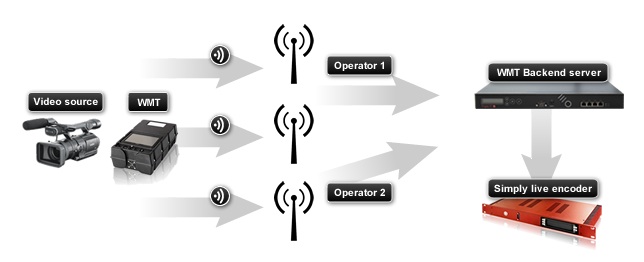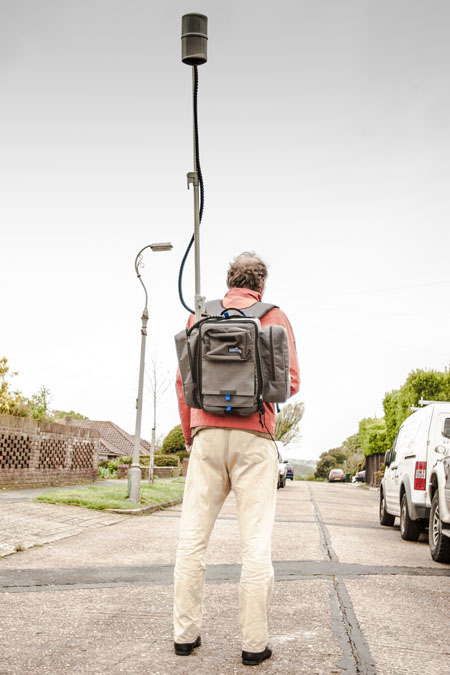Mobile Viewpoint Reviewed: A (Literal) Road Test
Every time I write an article about the link-aggregator and cellmux (video-specific link aggregator) space, a new vendor contacts me and berates me for not including their product, or for not reviewing the latest features they have. So I set about the whole process of asking them to send me a rig to try out, pointing out that I can’t know everything and I do absolutely rely on vendors reaching out to me, as much as I rely on Google Alerts to find me new vendor products as they appear.
Recently I approached Mobile Viewpoint of the Netherlands after a press release hit my desk announcing that they had been selected by the BBC for the mission-critical job of following the Olympic Torch relay as it completes its final stages on the way to London.
In response, Mobile Viewpoint MD Michel Bais reached out with a compelling email, essentially offering to simply fly over to my office in Brighton and lend me a rig to play with and test for a few days. Confidence in his kit really came over.
I have, on several occasions, sought cellmux rigs to play with for a few days on my own, to devise some form of scientific process by which to benchmark these technologies as I review them in these pages, and it has proven very difficult. Perhaps this has been my fault for suggesting I line up a “shootout;” as I have mentioned in previous articles, all the vendors have felt that a straight side-by-side shoot out could prove damaging to the positioning of their technologies, because each is highly susceptible to spurious environmental considerations such as contention on the local cell mast and with other similar devices. Most of the vendors have been concerned that my tests could adversely and unfairly represent their kit.
To an extent I can see their point. But with my cynic’s hat on, I also feel that if these companies are serious about offering this technology to newsgathering agencies (which they universally are), then they need to be pragmatic about the fact that in some circumstances this kit simply will not work.
Indeed, even the “highly reliable” satellite newsgathering (SNG) systems are on occasion hit by rain-fade. It’s just a fact—when you reach out to the edge, in the field, there are many risks that can affect your ability to get a signal back to base.
Anyway, I was extremely impressed by Bais. His own sales position and his own pragmatic viewpoint kept his expectations in line with reality and in line with what the technology really did. He wasn’t worried about it not working at times—of course that will be the case. He just took the view that if any of these cellmuxes could work, his would do the job well. There was little to add.
He simply flew over to England, sat in my house in Brighton with Hedley Baldwin (the UK reseller of Mobile Viewpoint), and we ran through the rig, and then he left it with me for a few days—something that none of the other vendors have yet done (and I invite them to do so in the future).
This gave me a brilliant opportunity to gather a few interested partners and to conduct a series of investigations and tests to (at least to an extent) scientifically review the rig and its capability.
The tests that we ran should broadly be possible with all these devices and so I can, in the style of Top Gear’s “Star in a Reasonably Priced Car,” now actually rationally benchmark these technologies, and I will now up the pressure on vendors to let me run this test on each of their devices as they come out.
Before I get into the test, how we conducted it, and how the Mobile Viewpoint rig fared let me just give you an overview of the Mobile Viewpoint technology.
How Mobile Viewpoint’s Technology Works
Mobile Viewpoint began as Triple IT, a company focussed on providing IP video technologies for security and road monitoring; when Bais joined from the GSM and mobile sector, he quickly pushed the idea of a video based link aggregator (or as you will know what I call a cellmux) and created Mobile Viewpoint. Leading with sales into the Dutch police and highway management they developed a series of technologies ranging from a small belt-pack device called 3G-MC up to the high-end, backpack-carried WMT.
So, like IBIS DMNG, TVUPack, and LiveU, they developed a backpack-carried product. The devices accept SIM card from data-enabled mobile operators and once the various APN names have been setup the modems hook up and each available data carrier is added to the pool of available routes and links for the device to forward its UDP video data over.
Once each packet is routed, it makes its way through the separate cellular networks, through their peering to the internet and over to the ISP to which the receiver unit, the WMT Backend Server, is collected. You can see the workflow in Figure 1.

Figure 1. The Mobile Viewpoint workflow
The receiver (techies would call it a demultiplexer) then buffers the stream a little (to allow for different packets arriving over different routes to be sorted into the right order), and decodes it. The output is then presented as an HDMI signal as I tested it, although other options are available, such as local streaming in RTSP, which we also used extensively in the testing).
About that Antenna
The first thing you notice about this rig is the backpack's size and its unique, slightly funky, and definitely not-discrete antenna (Figure 2). While the Teradek Bond, at the other end of the spectrum, uses the data services’ own “dongle” modems and their inbuilt antenna, looks like a spider when all its dongles are plugged in, and could be strapped on the back of an Action Man, the Mobile Viewpoint rig has a grey bulb on the end of a telescopic 2m long pole that forms its antenna. The pack, weighing in at around 8-10kg, would crush an Action Man; indeed even a 6’4” engineer looks reasonably laden with the Mobile Viewpoint system connected.

Figure 2. The sizable Mobile Viewpoint antenna on our equally sizable engineer. (Photo 2012 by Michael O'Rourke, www.lightwhispererphoto.com)
Certainly, if you are working on the frontline of a battlefield you are probably going to feel a bit like a target with 2m of cell-mast strapped to your back.
And this unleashes a set of interesting initial questions: When Bond has miniaturised to a camera-top model, and LiveU , IBIS, and TVU are the size of a box of chocolates (or smaller), all with an internal or small antenna solution, why does Mobile Viewpoint take such a stand-alone approach?
The truth is that Mobile Viewpoint is tightly focussed on operation, and not cosmetics. It turns out they added the antenna initially because a number of clients had expressed concern about having so much cellular “radiation” so close to their backs or heads for any prolonged period of time. The idea of the telescoping antenna was initially to put this transmission 2m away from the operator’s head. However this extension had a number of secondary benefits that actually made this modification a market differentiator.
This is not the first time I have zeroed in on antenna strategy as being the hub of the issue in the cellmux game. I have historically strongly favoured LiveU’s patented high-gain antenna system as crucial to its differentiation, and justifying LiveU’s market leading position. While it is unclear (to me at least) if TVU infringes on LiveU’s patents, I know that Bond, and IBIS don’t infringe the LiveU patent since they use the operators dongle-modems.
LiveU’s high-gain antenna gives them reach over the heads of local devices to further cell masts. This means that even if the local cell tower is saturated by whatever event is being covered, LiveU can reach those farther masts and get signal when others can’t. It must also be mentioned that a particularly challenging issue has been raised that actually this type of high-gain operation is, in some territories at least, not only outside of the standard operation setup of mobile phone networks, but may in fact be illegal because the high-gain process is non-standard and certainly could effect other users’ fair access to the networks. I will be investigating this claim in a future article, but it is founded in the fact that one public broadcaster I spoke to felt that it was risky enough that they couldn’t use the LiveU system for fear of regulatory compliance issues.
Mobile Viewpoint offers an alternative: By telescoping the normal antenna above the heads of the local crowd the single largest absorption of radio waves (the water molecules in the people at the event) is avoided, resulting in a significant optimisation of the data path.
Other vendors argued that the attenuation in the telescoped length counters any gain from the height, but given that the antenna is not actually primarily being raised to increase gain but to decrease radiation exposure to the operator, this secondary, experimentally proven (see later) optimisation is a real benefit.
Related Articles
What to look for in cellular multiplexing devices -- perhaps the fastest growing streaming technology.
23 Feb 2012
Yet another entrant in the "cellular multiplexer" field, the Teradek Bond offers reliable, good-quality streaming over cellular networks for a reasonable price
09 Feb 2012
Despite its decidedly unsexy name, the LiveU LU40i offers very exciting new capabilities, including a rich array of Layer 2 interfaces
15 Sep 2011
Aviwest is no longer the only chocolate box-sized live broadcast solution on the market.
08 Sep 2011
AVIWEST's IBIS DMNG is the latest and greatest in portable, cellular/Wi-Fi video broadcast units, and it's a terrific addition to a growing field
26 Jan 2011
Companies and Suppliers Mentioned